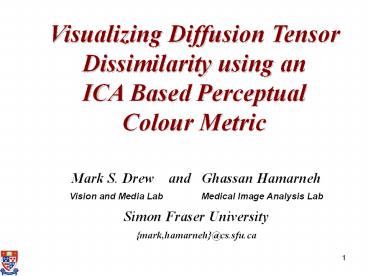Visualizing%20Diffusion%20Tensor%20Dissimilarity%20using%20an - PowerPoint PPT Presentation
Title:
Visualizing%20Diffusion%20Tensor%20Dissimilarity%20using%20an
Description:
should allow for easier evaluation for diagnosis, by medical experts ! ... LLE Locally Linear Embedding (based on proximity matrices via a graph) ... – PowerPoint PPT presentation
Number of Views:35
Avg rating:3.0/5.0
Title: Visualizing%20Diffusion%20Tensor%20Dissimilarity%20using%20an
1
Visualizing Diffusion Tensor Dissimilarity using
an ICA Based Perceptual Colour Metric
Mark S. Drew and Ghassan Hamarneh Vision and
Media Lab Medical Image Analysis
Lab Simon Fraser University mark,hamarneh_at_cs.sfu
.ca
2
Diffusion tensor imaging
- Diffusion Tensor a 3 x 3 matrix at each
voxel xx, xy, xz, yxxy, yy, yz, zxxz, zyyz,
zz - Data is MR signal enscapulates information on
water diffusion, at the voxel. - Brownian motion, but tends to follows tracts ?
can use to discover structure
Best reference Wandell, NIPS 2001 tutorial
Diffusion tensor imaging and fiber tractography
of human brain pathways
3
Higher diffusion along tracts ?
Complementary but different information from
more traditional T1- and T2-weighted spin-echo MR
data.
? Useful for tasks such as inverse problem of
locating epilepsy trigger locations from EEG
values use tensor values as electrical
conductivity tensor in generalized Poisson
equation.
4
xx, xy, xz, yxxy, yy, yz, zxxz, zyyz,
zz measurements in multiple directions
So, 9 variables at each voxel, But symmetric, gt
6 independent variables.
Traditional visualization use eigenvectors of
each tensor.
5
D is symmetric gt U is orthogonal, real.
6
The 3 columns of U are normalized 3-vectors, So
typically visualize D by showing an ellipsoid,
with axes along the eigenvectors, and lengths
? e.values.
(or other glyphs, e.g. superquadrics)
7
What about colour?
- Simple approaches have been used
- and, little attention has been paid to forming
colours that actually correspond to a difference
metric within the structure being imaged!
- Simply map the principal eigenvector at each
pixel into R,G,B - colour the three components of the first
eigenvector according to a pre-determined colour
map - multiply the 3x3 matrix times a probe vector,
and map to R,G,B etc.
8
So far, we looked at each voxel separately.
gt An approach to whole-brain analysis has been
to compute ICA components
9
Can we map main signal to brightness, and
modulate by assigning colour to other components?
gt That way, we code the main information into
the visual channel with the most acuity, and
reserve colour as a modulating factor encoding
the remaining ICA information.
10
Can we map a meaningful metric into a
perceptually meaningful metric in colour space?
- The Log-Euclidean metric for DT data
- Arsigny et al. MICCAI05
- taking logs shown to provide reasonable metric
- for differences between DTs at different voxels
- but wish to maintain positive semi-definite
property - so define Log function, via
- Log(D) U diag ( log ( diag ( ?) ) ) UT
11
Want to go to 6-vector representation, for
simplicity. But maintain same difference- measure
as for 9 components
12
ICA on 6-vectors, for practical data, generates
a rank-6 basis, B i.e., B is 6x6.
But B is not orthogonal, so must form
pseudoinverse to find coefficients.
13
Diffusion Tensor Data and Perceptual Colour
Consider brain scans (well use 256x256x55
voxels, from http//lbam.med.jhmi.edu/)
slice 25
T1-weighted
DT 1,1 component
14
DT is zero where there is no diffusion so form
2D convex hull to use foreground DT signal
gt v vec(Log(D)) So coeffs c F v gt lets
look at coeffs
1
5
3
2
4
6
15
sizes of these coefficients c
16
So, algorithm proposed here
- map 6D ? perceptual color L, a, b
- --------------------------------------------------
-- - map c1 ? L
- How to map remaining 5D into a,b?
- Form v (v c1 b1), perform ICA again
- Repeat in remaining 4D space.
17
(No Transcript)
18
Now map L, a, b to nonlinear sRGB display
space
- L, a, b ? XYZ tristimulus values (nonlinear
transform) - XYZ ? sRGBlinear (linear, plus clipping)
- sRGBlinear ? sRGB (if-statement
gamma-correction)
19
Test on a synthetic phantom
?
(plus 5 Gaussian noise)
20
Some results
slice 5
slice 50
slice 24
slice 26
slice 25
21
55 slices
scalar T1
tensor DT
tensor enhances perception of organization
connectivity
22
Test can this really help in visualization? --
Consider Corpus Callosum segmentation
vertical slice (sagittal)
23
Apply Tone curves to whole brain
24
Which measure can best discriminate regions of
distinct diffusion properties?
95 confidence intervals overlap cant
differentiate segments. ?
FA F-statistic29.9
log(D) F-statistic22.6
25
How do the 7 segments look in L,a,b?
CIELAB coordinates for the means in the seven CC
segments (coloured using the mean sRGB colour
from the histeq CC) substantial change in
CIELAB between segments.
26
Future
- ! Cleaner visualization We'd like to segment,
e.g. using extension of the Mean-Shift
segmentation algorithm - should allow for easier evaluation for
diagnosis, by medical experts - ! Other methods of assigning CIELAB using
distance-preserving dimensionality reduction - We've used ICA a linear method (as is PCA)
- Non-linear mappings
- -- MDS Multidimensional Scaling for assigning
location in a low-D space - -- LLE Locally Linear Embedding (based on
proximity matrices via a graph) - -- Isomap - another graph-based method for
nonlinear dimensionality reduction
27
Thanks! To Natural Sciences and Engineering
Research Council of Canada































